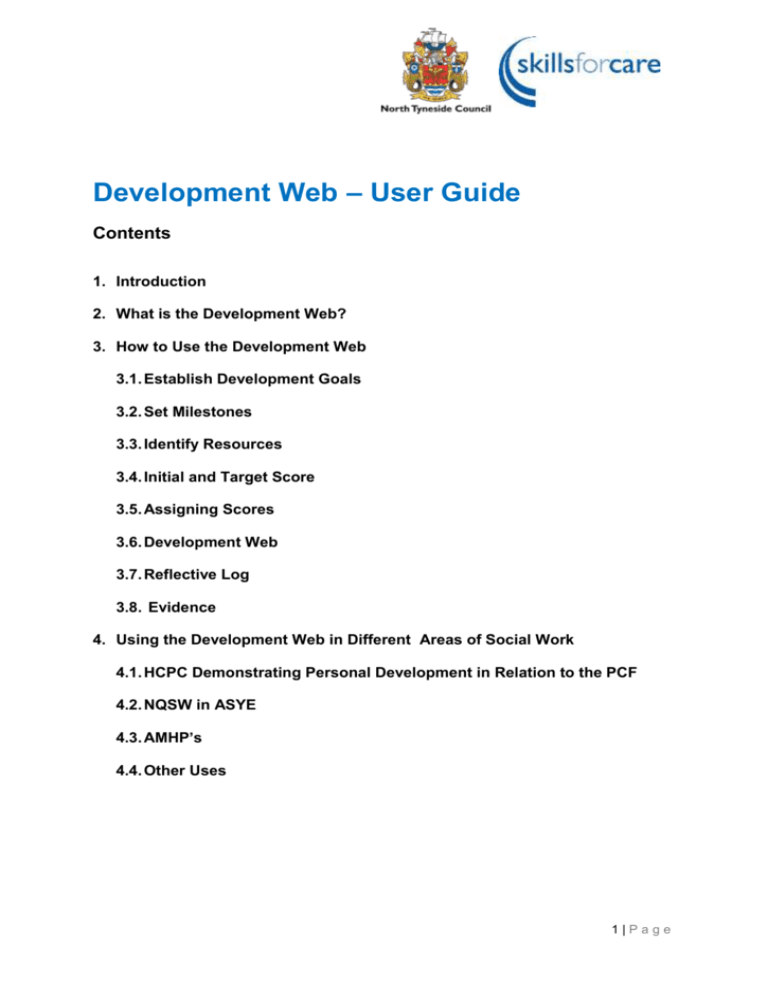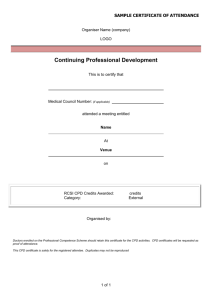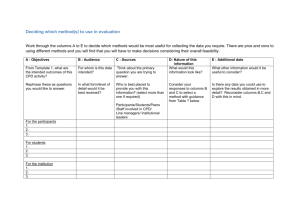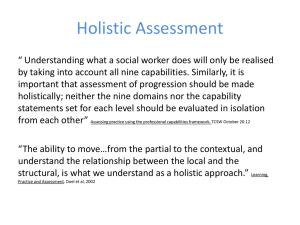Development Web - User guide
advertisement

Development Web – User Guide Contents 1. Introduction 2. What is the Development Web? 3. How to Use the Development Web 3.1. Establish Development Goals 3.2. Set Milestones 3.3. Identify Resources 3.4. Initial and Target Score 3.5. Assigning Scores 3.6. Development Web 3.7. Reflective Log 3.8. Evidence 4. Using the Development Web in Different Areas of Social Work 4.1. HCPC Demonstrating Personal Development in Relation to the PCF 4.2. NQSW in ASYE 4.3. AMHP’s 4.4. Other Uses 1|Page 1. Introduction Social workers at any level can use the Development Web to help target, track and evidence their professional development. The Development Web can help social workers to: Incorporate the Professional Capabilities Framework (PCF) into CPD Help to meet Health Care Professions Council (HCPC) CPD requirements Establish Development Goals and Milestones as part of a plan for personal development Reflect upon and record learning experiences Give structure to personal development by assigning scores and measuring progress at review points Maintain an ongoing record of CPD Visualise personal development through a graphic representation of progress Record evidence of CPD 2. What is the Development Web? The Development Web is an Excel workbook and consists of 5 parts: The Development Web – a web diagram that visually represents your developmental progress in relation to the domains of the PCF Scoring Table – a scale from 1-10 is used to score your development against the different PCF domains. Assigning scores populates the Web diagram Development Planner – where you establish your development goals and milestones Reflective Log – a place to record your learning experiences and reflect on their impact (this section also provides evidence of your learning and development) Evidence Log – A place to reference specific evidence relating to CPD activities 3. How to Use the Development Web Before entering any information into the Development Web itself, you should discuss your CPD/learning needs with your supervisor. This discussion should be informed by HCPC’s CPD requirements, and in relation to the PCF. 3.1 Establish Development Goals The first step after discussion with your supervisor, is to establish your Development Goals with your supervisor. Use the 2|Page Development Planner to do this: The Development Planners begin on the fourth sheet/tab of your workbook. The first column of the Planner tells you which PCF domain you are looking at, and the second column is where you enter your Development Goals. Development Goals are the outcomes you wish to achieve, and are the “big picture” Milestones are SMART objectives that you plan in between you starting point on the way to your Development Goals Activity is what occurs throughout your journey, through your milestones and toward your Development Goal There is a Development Planner for each domain of the PCF. Use the Development Planner to record Development Goals that you wish to achieve. You may have more than one Goal, in which case number them to keep track. TIP - The PCF gives detailed descriptions of what is expected of social workers at different levels of development. You can use these descriptors to inform your Development Goals. You may be working at different levels of the Professional Capabilities Framework – e.g. “Social Work” level in some domains, and “Experienced Social Worker” in others. Indicate at what level you are working in the “Development Goal” section of your Development Planner. 3|Page 3.2 Set Milestones The third column is where you can set milestones. These are shorter-term objectives that you and your supervisor agree should be completed on your way to achieving your longer-term Development Goals. Milestones could relate to anything significant to your personal development, and may be related to research, practice, or training. TIP – Make sure your milestones are specific, measurable, achievable, realistic and timely S.M.A.R.T! 3.3 Identify Resources The fourth column is where you can identify and agree with your supervisor any resources/training that will help you to progress your towards your Development Goals. 3.4 Initial and Target Score The fifth and sixth columns are ‘Initial Score’ and ‘Target Score.’ After working through the Development Planner with your supervisor, you are now ready to discuss a scoring system. The Development Web uses a scale 1-10. The points on the scale do not relate to a certain level of achievement; rather, you decide how to interpret the scale. For example: Sarah has Development Goals in 3 domains of the PCF She agrees with her supervisor initial scores of 1, 2 and 3 and target scores of 8, 9 and 7, respectively In some areas, Sarah recognises that she has a long development journey ahead of her In other areas, she has more pre-existing skills or knowledge, or has a more modest expectation of how far she would like to develop Sarah is thinking about how each domain relates to the other in terms of her own personal development She has used the scale to represent what progress means to her, personally The scale 1-10 is not prescriptive, and is not intended as a method of assessment. Instead, it provides a way of visualising your personal development, and tracking your progress. Discuss with your supervisor what the scoring system means for you, and how you can link it to your Development Goals. For managers and aspiring managers the 360 degree tool https://sw360.skillsforcare.org.uk/could be used to inform target ratings 4|Page 3.5 Assigning Scores Use the ‘Development Scores’ sheet: On the left hand column of the table are the PCF domains. The top rows are the review points, and the body of the table are drop-down menus that enable you to self-select a score. Assigning scores happens at three different points – the initial meeting, mid-point review and final review. At each review, you will discuss your progress against your Development Goals with your supervisor, and whether you have achieved any of your milestones. You also look over your reflective log/evidence and discuss any important learning experiences and how these have had an impact on practice and progression towards your development goals. . It will be useful to comment on the ratings and the discussion with your supervisor in the reflective log .This will capture valuable qualitative information that can be referred to at a later point. You can then agree a reviewed score. This score should be agreed upon by yourself and your supervisor, and be based on evidence and discussion. It should represent how far you have progressed and not be arbitrary. You may need to do more work, or you may have exceeded your expectations. The purpose of the mid-point review is to keep track of your progress against your Development Goals. The final review should show that you have achieved your target score, or exceeded it. As long as you can demonstrate (through evidence and discussion with your supervisor) that you have progressed against your Personal Development Goals, then you will have achieved your target score. 5|Page If you have not achieved your Development Goals or met your target scores, then you should try and demonstrate your progress. You could then create a new Development Web to carry this work over. 3.6 Development Web This is the graphic representation of your progress: The Development Web itself automatically populates when you assign yourself a score. The above screenshot shows a fully populated web with initial, mid-point and final stages. As you can see, the Web helps you to visualise your progress at different points. 6|Page 3.7 Reflective Log Use this to take time to reflect on your learning experiences and provide evidence of CPD: . Important CPD activity and the learning from this should be recorded in your Reflective Log, and can also be recorded as evidence of CPD in the Evidence tab (see below). TIP - When you have achieved a specific milestone set out in one of your Development Planners enter it into your Reflective Log. Put in a note or reference it so that you can show how it links to your Development Goal. 7|Page 3.8 Evidence Use this table to collect specific evidence of CPD activity: This will play an important part of your CPD profile if selected for audit by the HCPC. See HCPC guidance on how to complete a profile in case of audit for more guidance on collecting evidence of CPD activity. TIP – Follow this link to see an example CPD profile provided by HCPC: http://www.hpcuk.org/Assets/documents/10003F05BASW-seniorpractitionerdisabilityservicesFINAL.pdf 8|Page 4. Using the Development Web in Different Areas of Social Work 4.1HCPC Demonstrating Personal Development in Relation to the PCF - It is recommended that for social workers using the Development Web to evidence CPD in line with HCPC requirements, that you set one Development Goal for each domain of the PCF. However, if appropriate, you could set Development Goals in only certain areas – this would depend on the nature of your practice, and advice from your supervisor. You should still assign scores for the other areas, so that graphic element of the Development Web is used to full effect. Follow this link for HCPC’s Standards of Proficiency mapped against the domains of the PCF (http://www.hpcuk.org/assets/documents/10003B0BMappingoftheHPC%27sstandardsofproficiencyfo rsocialworkersinEnglandagainstthePCF.pdf) 4.2 NQSW in ASYE - You should meet with your supervisor at the start of your ASYE and agree specific Development Goals for each of the PCF domains. 4.3 AMHP’s - The College of Social Work have mapped the AMHP Competence Statements against the PCF (follow the link: http://www.tcsw.org.uk/uploadedFiles/TheCollege/Professional_development/PCF/A MHP%20Competency%20Mapping.pdf). 4.4 Other Uses - The Development Web can be used in any situation where a social worker needs to demonstrate their personal development in context with the PCF. It can be used by an individual creating an employment action plan. It can also be incorporated into IPR’s if required. 9|Page








